Bindi Block 8 Pinot Noir Australian Wine: A Peacock’s Tail Of Exploding Flavors
by Ken Gargett
Recently, I was looking at contenders for Australia’s best Pinot Noir. There are quite a few: Bass Phillip, By Farr, Main Ridge, Chatto, Hurley, Giaconda, Moorooduc Estate, Curly Flat, Kooyong, Freycinet, Paringa, Bannockburn, William Downie, Yabby Lake, Coldstream Hills, Ten Minutes by Tractor, Prancing Horse, and many others who will be outraged at being undeservedly left off the list. Many more have put up stellar Pinots on occasion but have not always exhibited consistency, which can be hard to do with this grape.
There is one maker, however, who has not only been extraordinarily consistent but produced world class Pinot (and Chardonnay) vintage after vintage across the board: Bindi Wines, thanks to owner and winemaker Michael Dhillon. It would be a brave critic to leave Bindi out of any list of great Aussie Pinots.
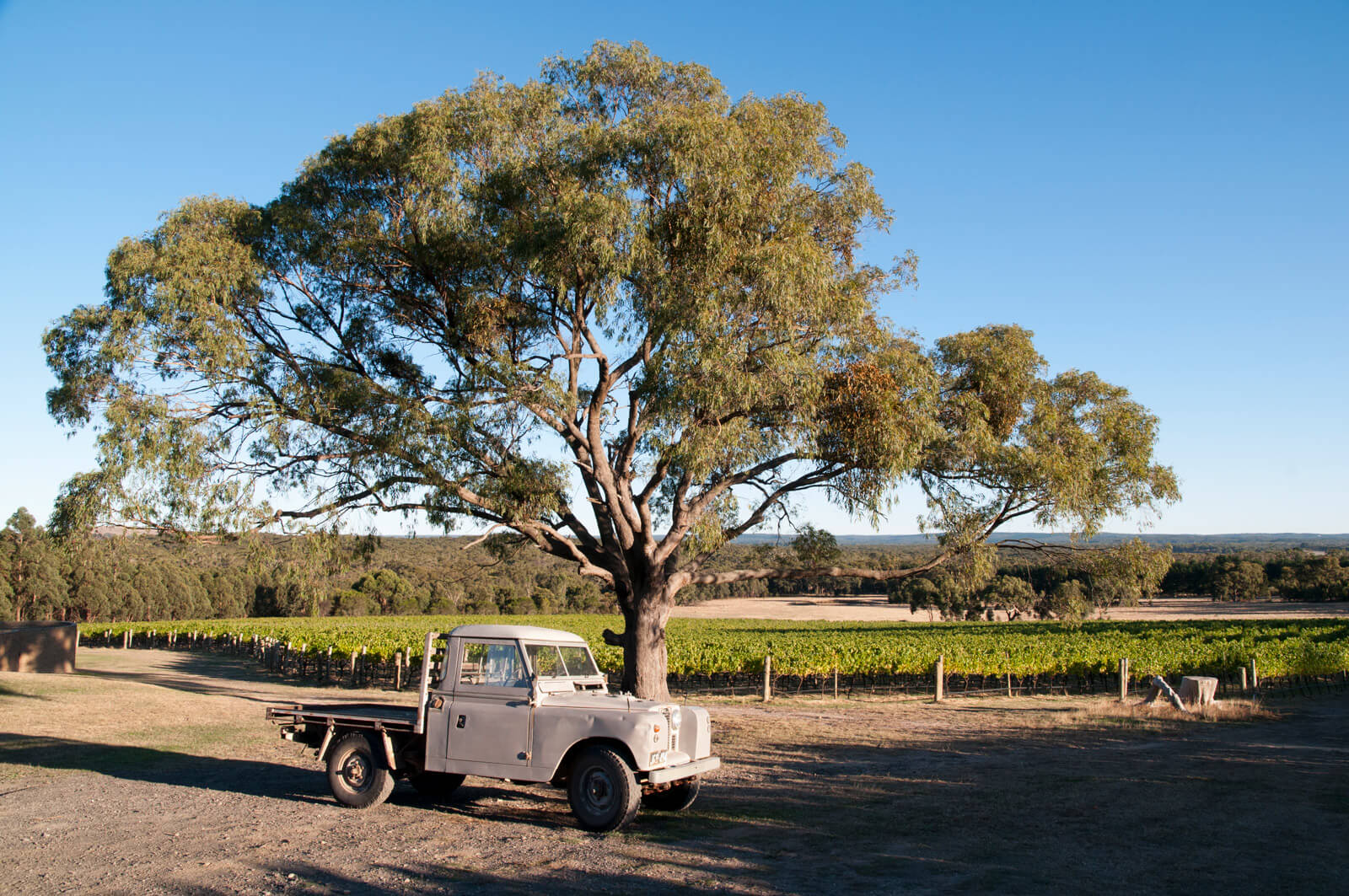
Bindi vineyards (photo courtesy Victor Pugatschew)
Anyway, I wanted to chat to Dhillon about his legendary Block 5 Pinot Noir, which is generally considered his best; however, he had not one but two surprises for me. Around eight years ago, he planted a new Pinot vineyard at his estate at Gisborne near Macedon in Victoria, Australia’s southernmost mainland state (plenty of superb Pinots also being made in the southernmost state, the island of Tasmania). Called the Darshan Vineyard, we are yet to see any wines released from it.
The second surprise was another, slightly more recent vineyard, Block 8, planted in 2016. Again, nothing released as yet, but the tiny handful who have tasted the wines made to date (very young for a vineyard, but sometimes they do throw up surprising results – the old saying in sports “if you are good enough, you are old enough” might apply here) have been stunned; one respected critic suggested that they are the best Pinots yet made in Australia. Another called them the closest thing to Chambertin seen in this country.
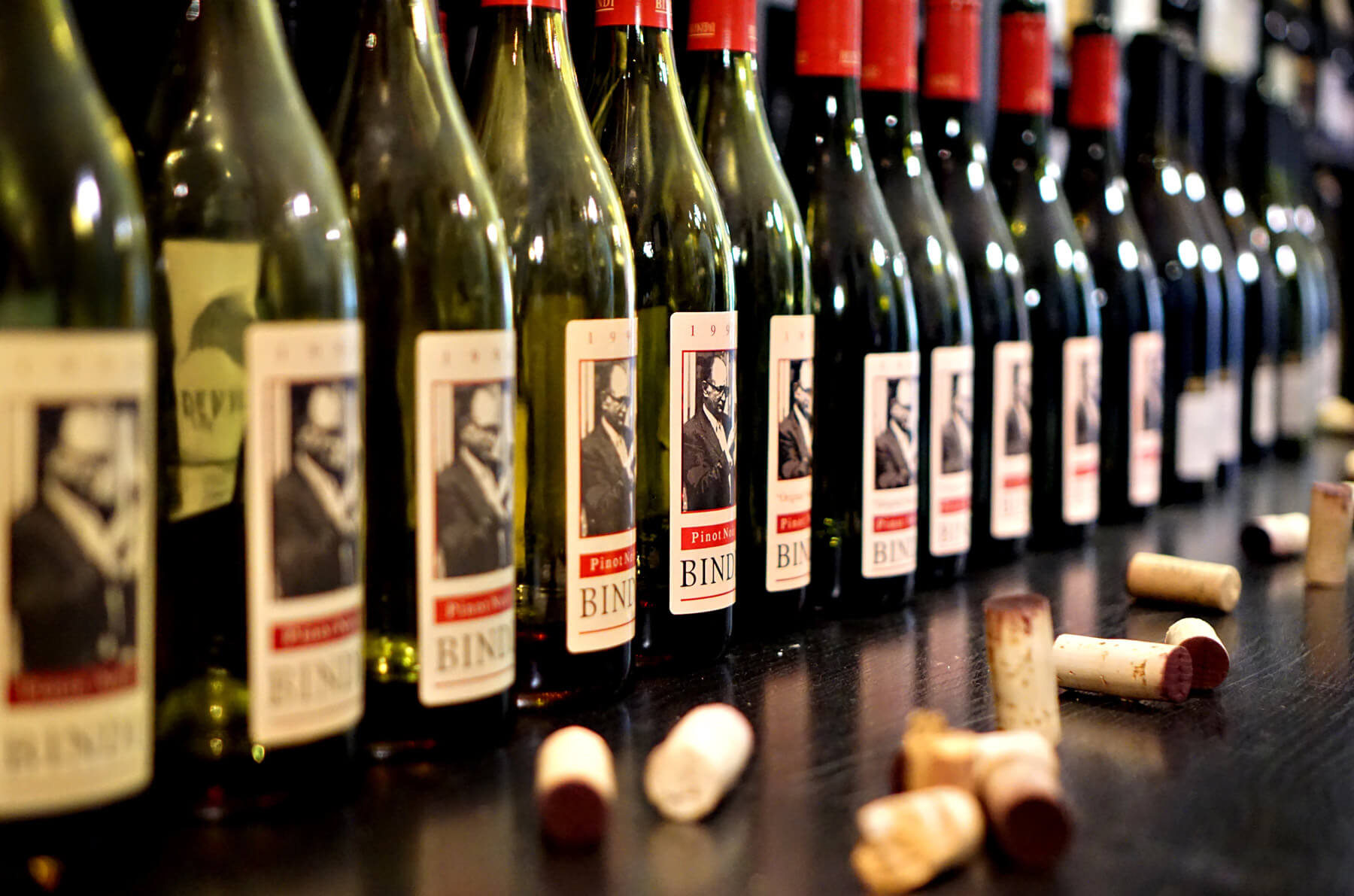
Bindi wines (photo courtesy Victor Pugatschew)
Why all the excitement for Bindi?
Dhillon, who once told me that he “doesn’t get excited until the wine is in the bottle,” is very excited indeed. The 2019 and 2020 are now in bottle, and he kindly sent me a barrel selection of the 2021 – it won’t be the exact final wine but will be very close.
He also told me, and this was before he’d even planted Block 8, that he believes that his wines don’t show all that well until they have received the requisite age, which in general is around six to seven years. He cited both 2004 and 1995 as examples: considered too light to begin with, they developed into rich, textured wines that he now sees as some of his best.
He even has kind words for the direction of his 2011, a pretty horrible year for most of Australia’s winemakers (never include Western Australia in those assessments – they simply wouldn’t know what a bad vintage is). Another was the very first Pinot Bindi made, the 1992. Considered an attractive, light Pinot in the early days, it hung in and just grew and grew in the bottle. The good news is that if these wines are showing so much at this early stage, are they likely to be even better be in a decade or two?
Michael Dhillon’s background
Dhillon is one of the most respected winemakers in Australia: humble, dedicated to the Burgundian varieties of Pinot Noir and Chardonnay, thoughtful, and exceptionally talented. I’ve never heard anyone with a bad word about the guy. He is, what we would call in Australia, a good bloke.
Like most great winemakers, Dhillon has not got where he is on his own; over the decades, he has enjoyed great support from family and friends. The Dhillon story for us begins in India, just south of Amritsar, home to the Golden Temple. Dhillon’s father, Bill, was born there in 1937, the youngest of six children. Bill’s father left for Malaya, as it was, to establish rubber plantations but regularly returned. This was the time of Partition and Amritsar is near the border with Pakistan, ensuring that this region suffered very badly from the violence with huge numbers killed. Bill and other members of the family were moved well out of harm’s way.
In 1950, Bill’s mother took the family to Malaya to join her husband, and in 1958 Bill arrived in Australia to study, first at Ballarat Grammar and then civil engineering at Melbourne University. It was here that he met Kostas Rind, a Lithuanian academic who had fled both the Nazis and Russian persecution and was now teaching math and physics in Australia. They became great friends.
Kostas introduced Bill to the joy of good wine, not the fortified wines enjoyed by the vast majority of Australians who drank wine in those days. He was remembered when the family named one of its original vineyards, planted in 1988, the Kostas Rind Chardonnay Vineyard (this was originally the Composition Chardonnay – the Composition Pinot Noir is now the Dixon Pinot, another family tribute).
Perhaps even more crucial to the story, Bill also met his future wife, Kaye, at this time. Kaye’s family had been in the Gisborne/Macedon region since the 1850s. Dhillon’s great-great-great-grandfather, Henry Gardner, was part of the famous Bendigo goldrush before eventually becoming the proprietor of the Telegraph Hotel. Kaye’s father had purchased a large property outside Gisborne and when he passed away it was spilt into three portions, Bill and Kaye inheriting the southern section. Dhillon told me that this was the larger portion – 170 hectares – but considered the least valuable land.
Bill named it Bindi. I had always assumed that must be because it had its fair share of the hated Bindi weeds with their painful little thorns, the bane of every young Aussie kid playing outside. Not so: “Bindi” is a Punjabi word meaning “wisdom and humility,” a far better reason for the name.
Bill established the property as a sheep station and the family also founded the local squash courts, but Bill had long harbored a dream to establish a vineyard. Dhillon said that his father had hoped to do so in the mid-1970s and sought advice from a famous winemaker (Dhillon did not name him but said he was still with us), who told Bill his property would not be appropriate. The plans were shelved.
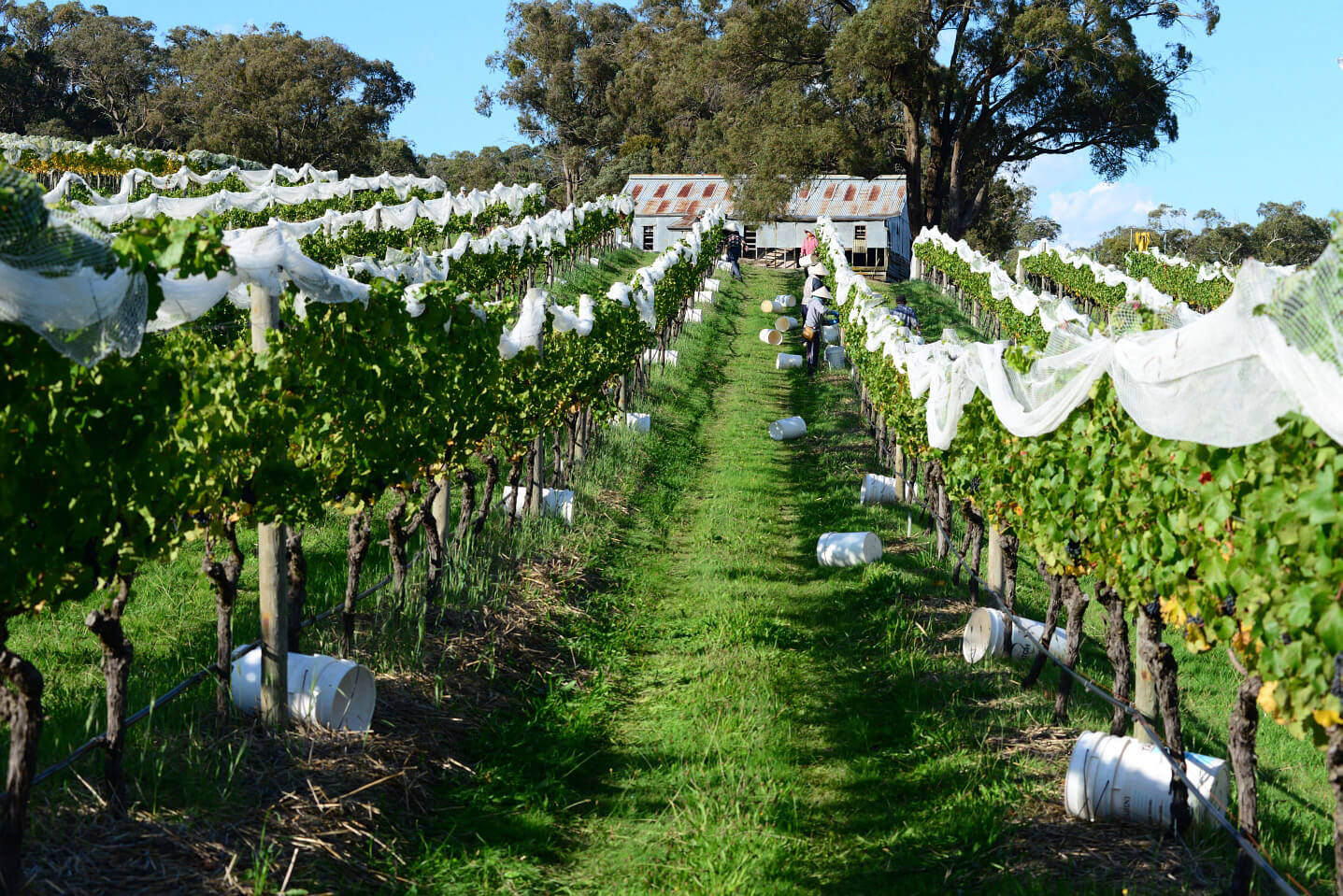
Bindi vineyards (photo courtesy Victor Pugatschew)
Bill did not give up and in the mid-1980s tried again. This time the advice was very different, and planting began in 1988. The sites chosen are free draining, north-facing, warm sites in a cool region (it can get very cold there). Bill’s focus was on the grapes rather than the winemaking, and he received advice and assistance from such luminaries as John Ellis (of Hanging Rock) and especially Stuart Anderson, founder of Balgownie, one of Australia’s earliest cult wineries. Indeed, Anderson’s Pinots in the early days were one of the few worth drinking and collectors went nuts over them. Anderson had sold Balgownie to Mildara Blass and moved to Gisborne.
The beginnings of Bindi wines
Bindi’s earliest vintages saw three barrels of 1991 Chardonnay made at Hanging Rock and two barrels of 1992 Pinot Noir at Mt. Gisborne by Anderson. Ellis made the Chardonnays through to the 1995 vintage and Anderson the Pinots up to 1997, plus the Chardonnays from 1996 and 1997, both working with Michael Dhillon, of course. In 1997, the winery was ready. Dhillon has made every Bindi wine since 1997.
The sheep are no longer in residence, but Bindi has planted a 14-hectare eucalyptus plantation of ironbark and sugar gums, which are used in the making of high-quality furniture. The majority of the property has been left to regenerate and provide a home for native wildlife and indigenous grasslands.
Dhillon grew up with wine as an everyday part of his life; on his twenty-first birthday, he received a dozen bottles of Henschke’s Hill of Grace (the 1983). He completed an economics degree at Monash University in Melbourne, but wine had taken hold by then. As well as working with the family estate, he did a vintage at the champagne house Jean Vesselle in Bouzy, another with Alain Graillot in Crozes-Hermitage, and four more with Tenuta di Valgiano in Tuscany.
Dhillon also worked with John Wade when he was establishing Howard Park during the mid-1990s. For Dhillon, no one bottle of Burgundy has completely flicked the switch as yet, but a 1985 Henri Jayer Richebourg came close.
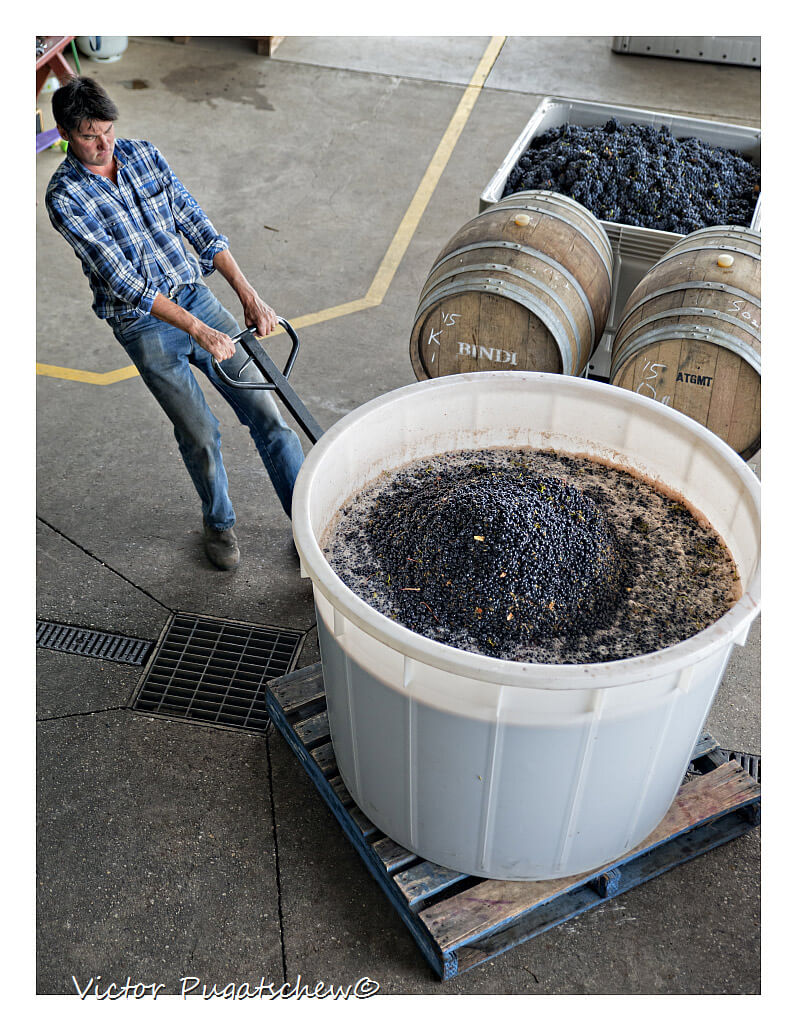
Michael Dhillon at Bindi wine (photo courtesy Victor Pugatschew)
Bindi vineyards
The Bindi vineyards are at an elevation of 500 meters above sea level, high for Australia. The soils are predominantly shattered quartz over siltstone, sandstone, and clay with some eroded volcanic topsoil over clay, which are generally infertile. Despite the size of the property, only a small amount is planted to vines, around seven hectares.
In 1988, Bindi planted the Kostas Rind Chardonnay Vineyard and the Quartz Chardonnay Vineyard. These two constitute two hectares in total, while the remaining five are devoted to Pinot Noir (Dhillon also sources some Shiraz from Heathcote for his Pyrette Syrah). The Original Vineyard, also planted in 1988, is devoted to Pinot Noir. In 1992, the famous Block 5 Pinot Noir vineyard was planted and then in 2001 Block K Pinot Noir.
Then we have the two latest exciting additions. The Darshan Vineyard in 2014 (a single acre) and Block 8 (just 1.9 acres) in 2016. Both of these are high-density vineyards with 11,300 vines per hectare in 1.1 x 0.8 m spacing. Dhillon has planted a small percentage of both vineyards with an even higher density: 22,600 vines per hectare.
Dhillon describes the soil in the Darshan Vineyard as “less dramatic” than that found in Block 8. It is a more even quartz, while Block 8 has a strong quartz influence at the top and more volcanic loam in the lower parts.
Dhillon has two more vineyards to plant and is hoping to do so within the next 18 to 24 months. There will be another acre of Pinot Noir, a continuation around the slope of Block 8. It will likely be medium density, around 5,000 to 6,000 vines/hectare. Those grapes are likely to form part of the Dixon Pinot. The second is 1.5 acres devoted to Chardonnay. It is on the quartz rise – in fact, the vineyard is so heavily dominated by quartz that Dhillon refers to it as Bindi’s “ultra-quartz” vineyard. This will sit separately. The vine density will range from around 5,000 to an astonishing 44,000 vines per hectare.
This focus on the single vineyards and their individual terroir is very much in the Burgundian tradition.
As for clones, Dhillon uses MV6, 115, Abel, 667, and in cool years 777. Some winemakers throw clones around like confetti. For Dhillon, “Lots of clones are a good thing if they are good clones.” For him, there are around five to seven clones that work, but others will do good things in certain conditions, though he believes that the clones lose their impact with age.
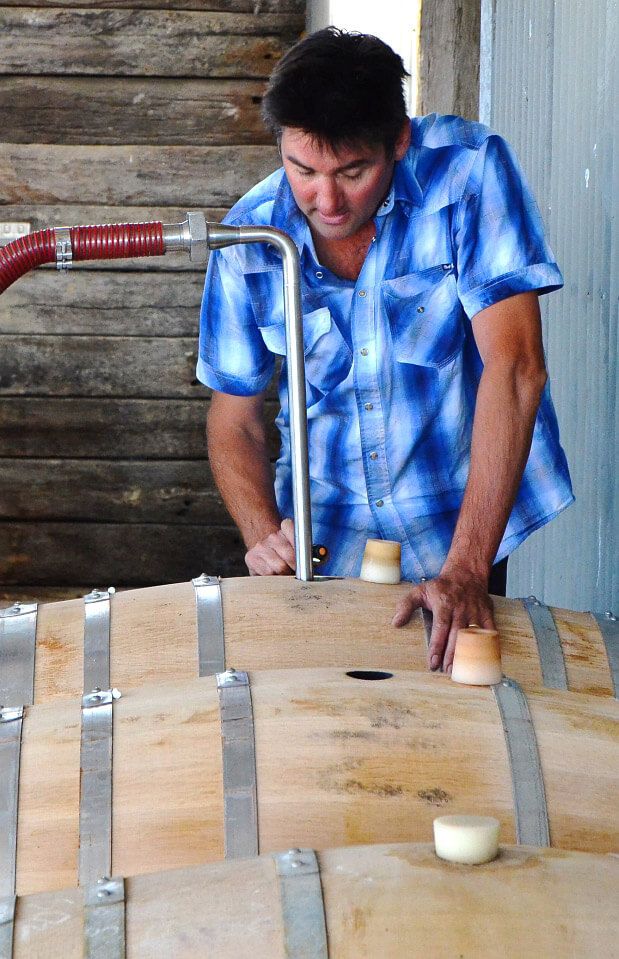
Michael Dhillon at Bindi wine
Yields are low, typically around 3.5 to 5 tonnes per hectare, but in Block 8 it is ridiculously small – around 280 grams/vine.
Vineyard management and winemaking is both hands off and extremely detailed, if that makes sense: hand-pruning, frequent passes (an impressive ten passes or more for each vine), and hand-harvesting. Dhillon doesn’t label his viticulture either organic or biodynamic, though it is obvious that he takes what he sees as the best from both. Fermentation is with native yeasts and there are no additions. Unsettled Chardonnay juice is transferred straight to barrel, while the reds see gentle pressing, long lees aging in French barrels, and minimal racking. There is no fining and a restricted filtration regime maintained. Oak is always beautifully handled and the contribution from new barrels restricted.
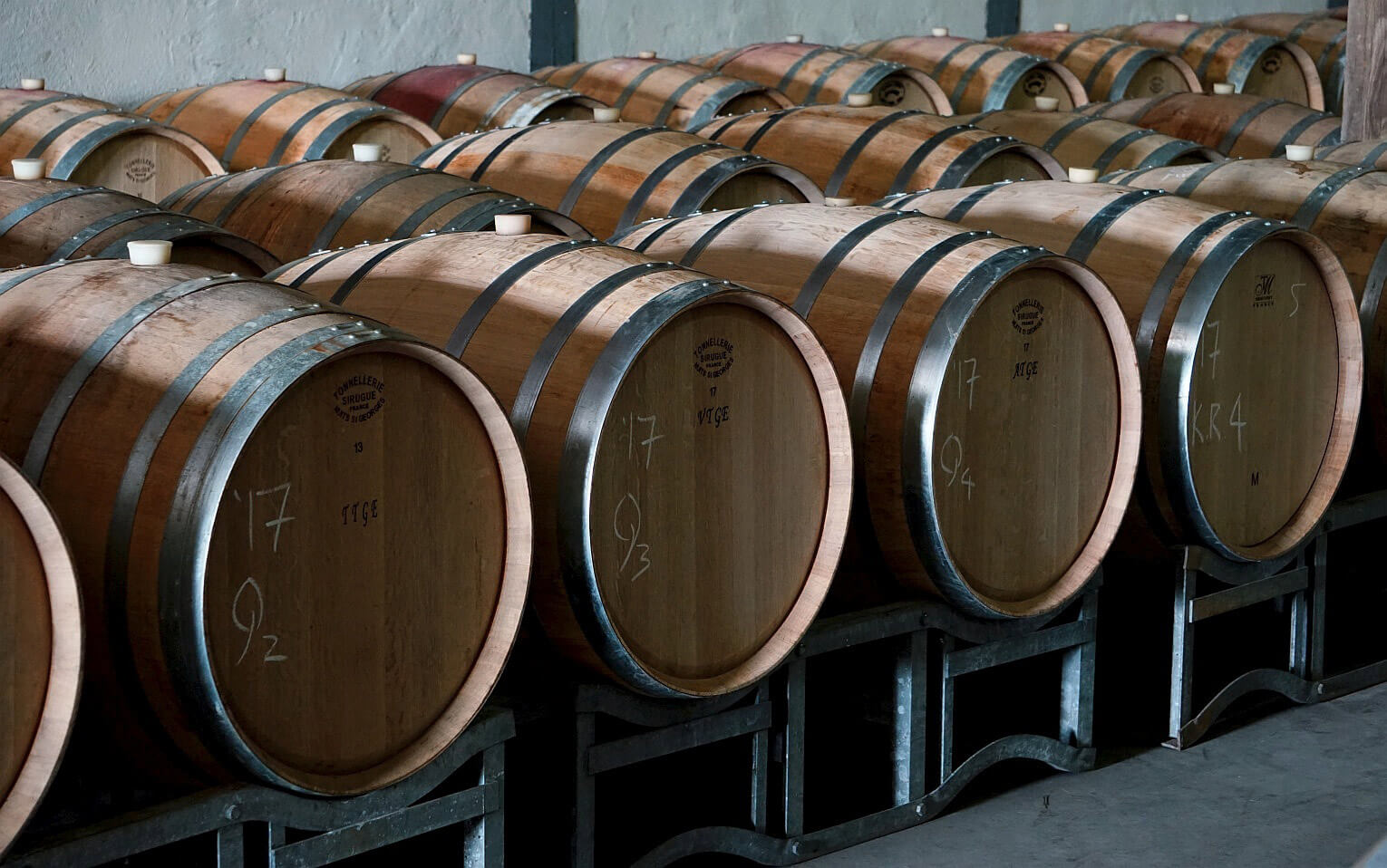
Bindi oak barrels (photo courtesy Victor Pugatschew)
Typically, the wines see around one-third new oak, but Block 5 has proven itself able to take 40 to 50 percent new oak in some years. Block 8 has the power and richness to handle up to half of its production in new oak. Even in lighter years like 2020, it still saw one-third – something I would never have picked.
I could just as easily have focused on any of the Bindi wines. They are spectacular across the board. I do have one issue with Dhillon, though: he made a couple of amazing sparkling wines that spent a great many years on lees before release. They were some of the country’s most exciting, but sadly he stopped. Understandable as the production of quality fizz is tough enough for the big players, let alone the tiny producer, but I miss them. Hopefully, we’ll see them again, but given the length of time involved to make a sparkler, be in no hurry.
I asked Dhillon when he might resume production. He just laughed and said that every year he thinks about it, but the requirements and the amount of work make it unrealistic, especially when it would rob fruit from the still wines, which sell out so quickly.
Back to the new vineyards. Dhillon has always been very interested in close planting and what it can achieve. There is much more to great wine than just close planting, but it can, in certain circumstances, play a contributing role. Vineyards like those at Bass Phillip, Ten Minutes by Tractor, and La Serre at Banockburn piqued interest. There are numerous others. Viticulture needs to be tailored to the new structure, and Dhillon has spoken of just how much he is learning. “A pragmatic pursuit of passion.”
The choice of clones was crucial. These vineyards have been in the planning stages for over a decade and, as Dhillon says, “The Darshan clonal mix was determined in 2012 and nods to old Australia with the focus on MV6, a clone believed to have come to Australia in 1831 with James Busby [it’s about as Australian as it gets when it comes to vine material]. MV6 has proven to be an excellent clone for small bunches and small berries and both Block 5 and Original Vineyard are 100 percent MV6.” He also included 777, Pommard, and Abel. The division is “50 percent MV6 with 115, 777 and Pommard in equal proportions.” More Abel was used in Block 8. Irrigation was included in the vineyards but is used less frequently each year. The closer plantings play a role in providing more shading for the bunches and so experience less loss of moisture.
Dhillon was keen to go for close planting and this 0.4 hectare is planted to 11,300 vines per hectare. As mentioned, he does have a small part of it at twice that. In 2021, the 4,750 vines produced just 900 bottles. Dhillon needed to purchase a special Niko tractor from Germany to deal with the tiny spacing between rows that is just 68 centimeters wide.
Dhillon has noted the quality increasing every vintage; production for the full estate usually ranges between 1,800 to 3,000 dozen cases per vintage.
The Darshan vineyard was planted in 2014. The vineyard is named after Michael’s father, Bill, whose real name was Darshan Singh Dhillon and who passed away in January 2013. He adopted “Bill” as Darshan was a touch too difficult for Aussies back in the late 1950s.
Top-notch Aussie Pinot certainly, but as Dhillon says, “Darshan is an Indian name for a wine made from a French variety. It is processed with Italian winemaking equipment then matured in French barrels. It comes from ancient First Nation’s land managed for 40,000 years.
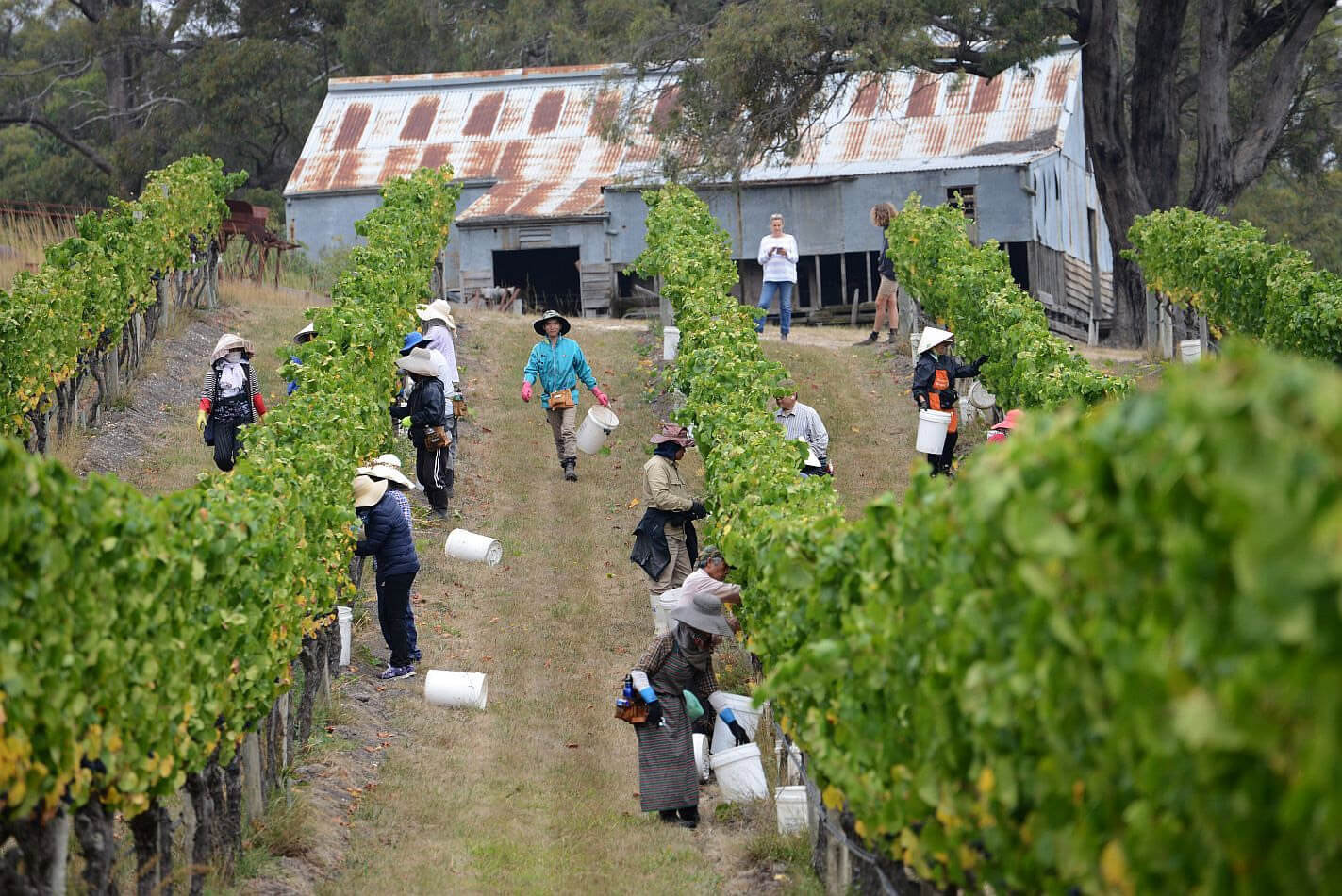
Grape picking time at the Bindi vineyards
The vines are farmed by Australians of various descent (Indian, British, and Vietnamese) utilizing Japanese, American, French, Australian, and German equipment.”
Bindi Block 8
Block 8 is the focus for today. Planted in 2016, it is 1.888 acres with 8,888 vines. This is the eighth block planted at Bindi, which was established in 1988. (If only we could still sell to the Chinese!) For those familiar with Bindi (I suspect very few as there is no cellar door and it is devilishly hard to find), this is a continuation around the slope of Block 5. The ridiculously low yield has been noted. The vineyard usually provides around six barrels (1,800 bottles). Dhillon sees these as next-level Pinots with their purity and depth.
The wines are exported and, Covid permitting, Dhillon aims to tour the important markets to showcase these wines to local critics and retailers on release. The plan is that the first releases of both Block 8 and Darshan will be in April or May of 2023. The price has not been set but is likely to come in around AUD$150 to 200, making them fabulous bargains compared to what we are seeing from Burgundy.
Surprisingly, the first release will be of the 2021s. The early vintages will be subsequently released in combination six-packs. Dhillon was keen to learn as much as possible about the new vineyards before any were released and to give the vines some age as well as allow some evolution in bottle.
It is important to note that for Dhillon all the vineyards have their own personalities and the difference between vintages is simply down to the conditions of the season. He stresses that, “Season cannot trump site.” For him, the site is “king and queen.” The season might vary things, but the site will always triumph.
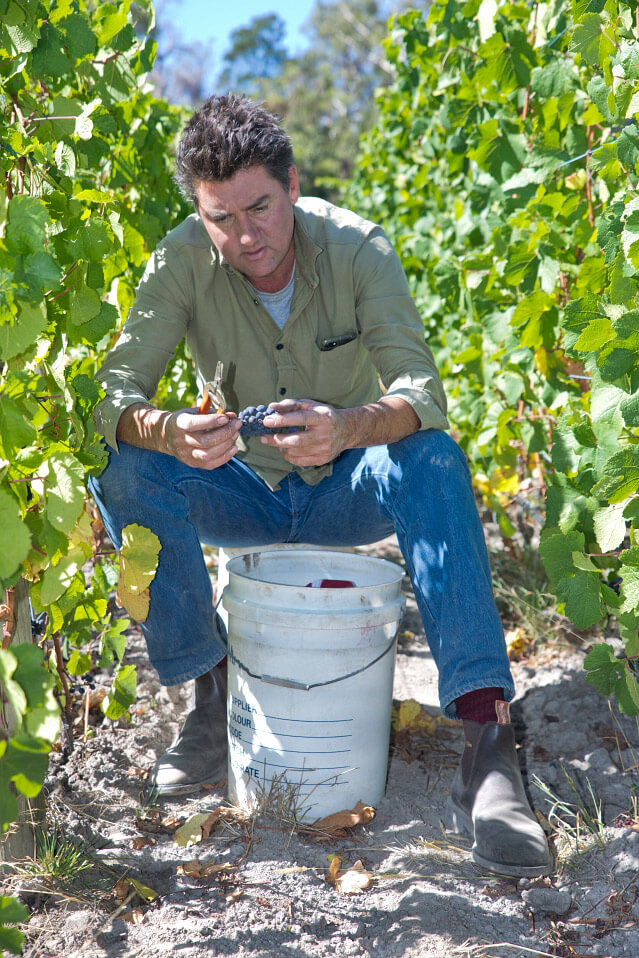
Michael Dhillon checking grapes at the Bindi vineyard (photo courtesy Victor Pugatschew)
Bindi Block 8 tasting notes
Bindi Block 8 Pinot Noir 2019. The oldest of the trio and at this stage, not surprisingly, the most complete. Deep maroon/red in color. It has a glorious Pinot nose, imperiously pure. Red fruits, spices, florals, violets. Supple and delicate and yet has richness, power, and drive. Still youthful, of course, and slightly closed. There are gentle coffee/cocoa powder traces and new leather. Fresh, such beautiful aromatics. There is also a minerally undertow.
Seamless, taut, focused, this has some serious grip. Abundant tannins but ever so silky. More coffee bean notes and dried herbs on the finish. Excellent length. Surely a decade plus ahead of it. Early complexity and it finishes with that ever-elusive peacock’s tail of exploding flavors. What will it be like on release? Hard to see it not reaching even greater heights. 97-98.
Dhillon describes this wine as from the warmest, driest vintage but there was a cool March, allowing for the freshness we find, on top of the richness.
Bindi Block 8 Pinot Noir 2020. Extraordinary difference even to the eye, before one takes the first sniff. A much paler color. Pale red/ochre. You’d swear this was the elder of the two on sight. Much sappier on the nose, brambles. Gives the impression of whole bunch inclusion, though Dhillon assures me that there is zero – it is all the conditions provided by the vintage.
This was a very cool, damp year with a small crop. It was harvested three weeks later than in 2019. Dried vegetation, red fruits, cherries, dried herbs, and forest floor notes. A much more savory style. So different to the 2019. Silly tannins, very good length, and an appealing elegance and purity. Lingers beautifully, this has six to eight years to peak. 95-96.
Bindi Block 8 Pinot Noir 2021. This is a combination of selected barrels that Dhillon prepared for me, though it will surely closely mirror the finished wine, which will be bottled in July of 2022. This was a superb vintage, cool, but then the “best ever final two weeks,” which allowed for the richness and complexity we find. At the moment, incredibly young and still forming. Vibrant purple in color.
At this stage, as a barrel sample, no surprise that there is much more oak evident here. Nutmeggy oak. On the nose, glorious. Spices, black fruits, black cherries/cassis, bergamot, and a note like a fresh blueberry pie. This is a thrilling wine. Such incredible potential.
Delicious already though much more to come. Good, bright acidity. Fine balance and amazing length. This should top the lot. Dhillon and I are in agreement on that, although he has no doubt that he will be able to better it in the future. It all depends on the vintage conditions. 98-99.
For more information, please visit bindiwines.com.au.
You may also enjoy:
Penfolds G3: Making Grange, Already One Of The World’s Greatest Wines, Even Better
Leave a Reply
Want to join the discussion?Feel free to contribute!



You write good content. I like your blogs, and they seem great. Keep growing.
thanks NH3600. much appreciated.
Totally agree – fortunate enough to visit and taste all the 2021s from barrel and the Block 8 is nothing short of stunning.
Thanks Tez. Great place to visit if you can get there.